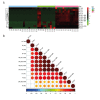Lipidomic Components Alterations of Human Follicular Fluid Reveal the Relevance of Improving Clinical Outcomes in Women Using Progestin-Primed Ovarian Stimulation Compared to Short-Term Protocol
- PMID: 29783268
- PMCID: PMC5989624
- DOI: 10.12659/MSM.906602
Lipidomic Components Alterations of Human Follicular Fluid Reveal the Relevance of Improving Clinical Outcomes in Women Using Progestin-Primed Ovarian Stimulation Compared to Short-Term Protocol
Abstract
BACKGROUND Increasing the success rate of in vitro fertilization/intracytoplasmic sperm injection (IVF/ICSI) is a duty of clinicians that has made many seek a variety of protocols. This study was undertaken to use a liquid chromatography-mass spectrometry (LC-MS) to define the alterations of follicular fluid (FF) lipid metabolites in patients undergoing progestin-primed ovarian stimulation (PPOS) compared with short-term protocol, revealing potential correlations between the differentially expressed lipids and ameliorative clinical outcomes. MATERIAL AND METHODS Ninety-three infertile women undergoing IVF/ICSI treatment with PPOS (n=62) or a short-term protocol (n=31) were prospectively enrolled in a randomized controlled trial. FF samples were obtained from dominant follicles at the time of oocyte retrieval. Lipid metabolism profiles were analyzed using LC-MS. RESULTS Twelve lipids were found to be higher in patients treated with the PPOS protocol than in those receiving the short-term protocol, including triacylglycerols (TAG-34: 1+NH4, TAG-58: 0+NH4, TAG-64: 3+NH4, and TAG-64: 8+NH4), diacylglycerol DAG-38: 6+NH4, phosphatidylglycerols (PG-26: 0, PG-30: 2, and PG-40: 5), phosphatidylethanolamine PE-32: 2, lysophosphatidylethanolamine LPE-14: 1, lysophosphatidylinositol LPI-12: 0, and lysophosphatidylcholine LPC-16: 0. CONCLUSIONS Our data demonstrate that the PPOS protocol increases the levels of 12 lipids in FF, which reveals a strong association between the differentially elevated lipids and better IVF/ICSI outcomes.
Conflict of interest statement
None.
Figures




Similar articles
-
Effect of Progestin-primed Ovarian Stimulation Protocol on Outcomes of Aged Infertile Women Who Failed to Get Pregnant in the First IVF/ ICSI Cycle: A Self-controlled Study.Curr Med Sci. 2018 Jun;38(3):513-518. doi: 10.1007/s11596-018-1908-z. Epub 2018 Jun 22. Curr Med Sci. 2018. PMID: 30074220
-
New application of dydrogesterone as a part of a progestin-primed ovarian stimulation protocol for IVF: a randomized controlled trial including 516 first IVF/ICSI cycles.Hum Reprod. 2018 Feb 1;33(2):229-237. doi: 10.1093/humrep/dex367. Hum Reprod. 2018. PMID: 29300975 Clinical Trial.
-
Metabolomics analysis of follicular fluid in ovarian endometriosis women receiving progestin-primed ovary stimulation protocol for in vitro fertilization.Sci Rep. 2023 Apr 7;13(1):5747. doi: 10.1038/s41598-023-32797-w. Sci Rep. 2023. PMID: 37029234 Free PMC article.
-
Efficacy of progestin-primed ovarian stimulation in women with polycystic ovary syndrome undergoing in vitro fertilization: a systematic review and meta-analysis.Front Endocrinol (Lausanne). 2023 Sep 19;14:1224858. doi: 10.3389/fendo.2023.1224858. eCollection 2023. Front Endocrinol (Lausanne). 2023. PMID: 37795363 Free PMC article.
-
Comparison the effects of progestin-primed ovarian stimulation (PPOS) protocol and GnRH-a long protocol in patients with normal ovarian reserve function.Gynecol Endocrinol. 2023 Dec;39(1):2217263. doi: 10.1080/09513590.2023.2217263. Gynecol Endocrinol. 2023. PMID: 37236243 Review.
Cited by
-
Lipid Identification and Transcriptional Analysis of Controlling Enzymes in Bovine Ovarian Follicle.Int J Mol Sci. 2018 Oct 20;19(10):3261. doi: 10.3390/ijms19103261. Int J Mol Sci. 2018. PMID: 30347829 Free PMC article.
-
Metabolic signatures in human follicular fluid identify lysophosphatidylcholine as a predictor of follicular development.Commun Biol. 2022 Jul 29;5(1):763. doi: 10.1038/s42003-022-03710-4. Commun Biol. 2022. PMID: 35906399 Free PMC article.
-
Study on follicular fluid metabolomics components at different ages based on lipid metabolism.Reprod Biol Endocrinol. 2020 May 12;18(1):42. doi: 10.1186/s12958-020-00599-8. Reprod Biol Endocrinol. 2020. PMID: 32398082 Free PMC article.
-
Effect of medroxyprogesterone acetate dose in progestin-primed ovarian stimulation on pregnancy outcomes in poor ovarian response patients with different body mass index levels.Front Endocrinol (Lausanne). 2024 Apr 18;15:1352522. doi: 10.3389/fendo.2024.1352522. eCollection 2024. Front Endocrinol (Lausanne). 2024. PMID: 38699386 Free PMC article.
-
Recent progress in metabolomics for analyzing common infertility conditions that affect ovarian function.Reprod Med Biol. 2024 Sep 30;23(1):e12609. doi: 10.1002/rmb2.12609. eCollection 2024 Jan-Dec. Reprod Med Biol. 2024. PMID: 39351127 Free PMC article. Review.
References
-
- Macklon NS, Stouffer RL, Giudice LC, Fauser BC. The science behind 25 years of ovarian stimulation for in vitro fertilization. Endocr Rev. 2006;27:170–207. - PubMed
Publication types
MeSH terms
Substances
LinkOut - more resources
Full Text Sources
Other Literature Sources

